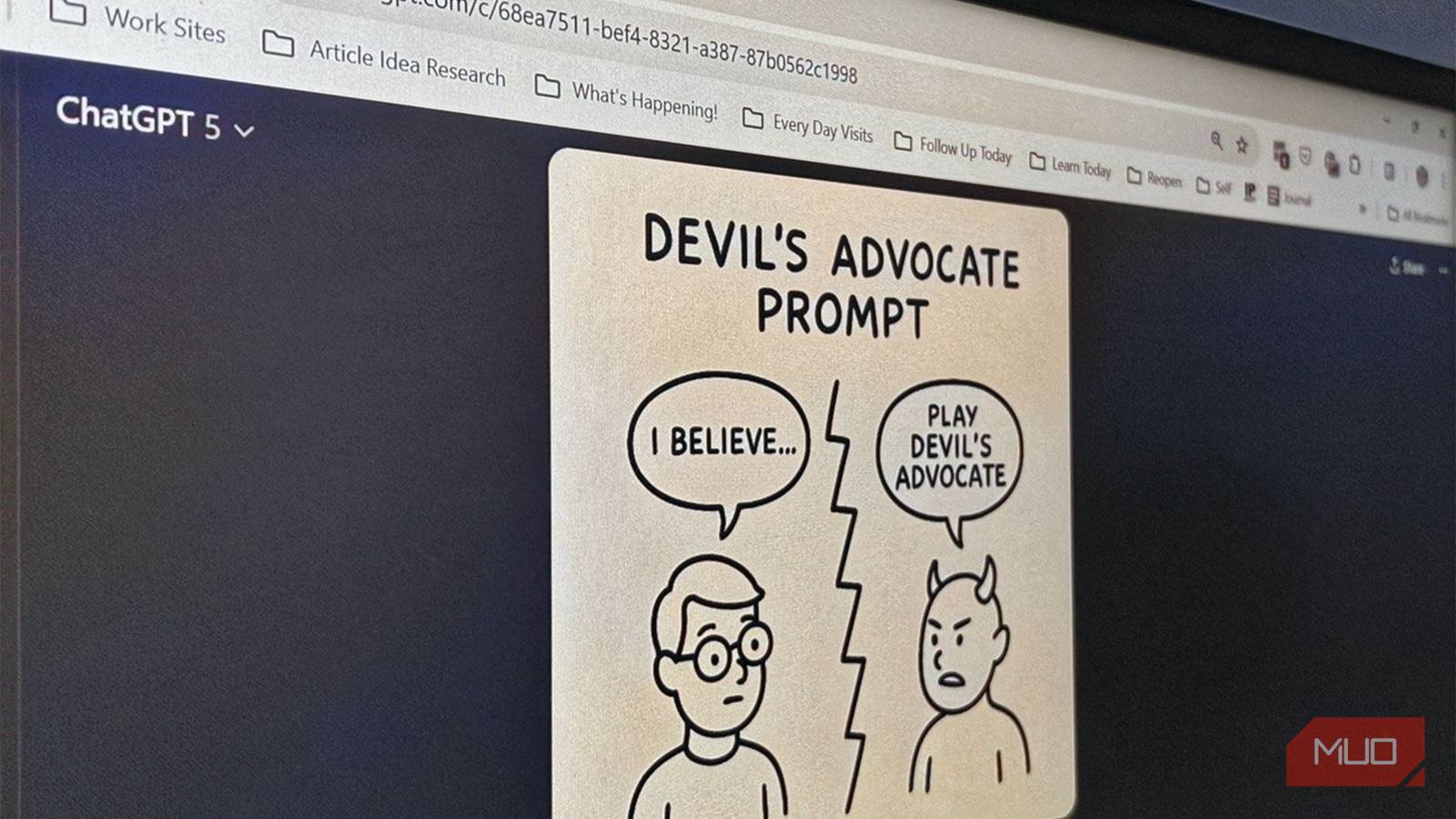ChatGPT is famously polite (and so are we). It agrees, elaborates, and rarely challenges you. Its lightning-fast answers make us feel productive. But after a while, the responses sounded smart but safe. I realized the importance of making AI stop agreeing with me. I didn’t want it as an echo chamber, but a thinking partner.
One day, I typed: “Play devil’s advocate and argue against my idea.” With this tweak, ChatGPT went from agreeable assistant to critical partner. It uncovered weak arguments, questioned my logic, and even highlighted blind spots. Since then, the “devil’s advocate prompt” has become one of my favorite learning tools.
Why ChatGPT needs a devil’s advocate mode
When AI agrees too much, we stop thinking
ChatGPT is designed to help. Its default tone is friendly and affirming—it expands on your ideas instead of dismantling them. That’s fine if you want a quick explainer. But if you’re trying to think or learn, constant agreement is counterproductive.
Human reasoning needs some friction. We improve when our ideas are tested by skepticism and nuance. Without that, even smart people end up believing flawed assumptions.
I noticed this when I asked ChatGPT for productivity tips. It gave me a list of familiar answers: “Plan your day,” “Prioritize,” “Avoid multitasking.” All fine advice—but nothing novel. So I replied:
Now play devil’s advocate. Tell me why this advice might actually make me less productive.
The tone flipped. ChatGPT argued that over-planning could lead to decision fatigue, that rigid scheduling reduces creativity, and that single-tasking isn’t always ideal in fast-paced jobs.
In one sentence, I’d unlocked a deeper, more nuanced version of the AI; one that questioned assumptions rather than repeating them. I realized that you don’t always need better data or a more advanced model. You just need to put some pressure on your AI to disagree.
The simple prompt that changes everything
Force ChatGPT to challenge your assumptions.
The core of this idea is just one prompt:
Act as a devil’s advocate. Challenge my argument about [topic] by pointing out flaws, counterarguments, missing evidence, and possible unintended consequences. Assume your goal is to make me doubt my position.
It looks simple, but it transforms ChatGPT’s reasoning process. Instead of reinforcing your perspective, the model shifts into critique mode. It becomes analytical, skeptical, and much closer to how a sharp human mentor would respond.
Here’s how I’ve used it in different contexts:
1. For learning
When I finish reading a book or article, I summarize its key idea and then ask ChatGPT to attack it. For example:
The book argues that process is more important than goals. Play devil’s advocate.
ChatGPT countered that some people perform better with task-switching, that creative work often requires cross-pollination of ideas, and that ‘multitasking’ can mean different things depending on context. That one exchange made me understand the concept more deeply than rereading the chapter ever could.
2. For decision-making
Before committing to a new project, I’ll outline my plan and invite criticism:
Here’s my plan to launch a newsletter about AI and creativity. As a devil’s advocate, list five reasons it might fail.
The AI pointed out realistic risks: niche fatigue, unclear differentiation, time cost, lack of monetization, and dependency on platform algorithms. It wasn’t deflating, but strategic.
3. For self-improvement
I even use it to challenge personal beliefs:
I believe I procrastinate because I’m a perfectionist. Play devil’s advocate.
ChatGPT argued that maybe I’m not afraid of imperfection but of irrelevance; that I might use perfectionism as an excuse to avoid discomfort. That hit hard, and it helped when I thought deeply about it. The point isn’t to agree with everything it says. The point is to make the invisible visible; to see where your thinking might be thin.
Turning friction into a learning habit
Spar with AI to burnish your critical thinking
Once you experience it, it’s hard not to make it a habit. The devil’s advocate prompt gives ChatGPT a more honest personality that it rarely shows.
I now use it as part of a simple three-step reflection loop:
- Ask: Present my idea or belief.
- Argue: Ask ChatGPT to play devil’s advocate.
- Adapt: Reflect on what changes or holds up after critique.
This small habit has made my learning stickier. Research in cognitive science shows that testing, contrast, and self-explanation strengthen memory. When you force your brain to defend or revise ideas, you retain them longer.
You can vary the intensity, too. Sometimes I ask for gentle opposition (“Challenge this idea lightly”). Other times, I go all in (“Argue as if my idea is completely wrong”). The model adapts, and you can compare the answers.
It also helps emotionally. Using disagreement as part of the process removes any feelings of threat. When the pushback comes from an AI, you can explore doubts safely. Theirs no ego to get in the way.
Here’s a quick way to test it yourself:
Play devil’s advocate. Challenge my view on [insert belief or goal]. List three flaws, one emotional bias, and one question that would make me rethink my stance.
Feed it any idea. You’ll see how fast the conversation deepens.
Arguing better is a thinking skill
The devil’s advocate prompt reminded me that disagreement isn’t the opposite of intelligence; it’s a key part of asking better questions. By teaching the AI to argue back, I made myself more reflective, less certain, and ultimately more creative. Of course, you can also try out the same prompts in an unorthodox AI chatbot like Grok and test the differences.
So, in your conversations with ChatGPT, give it permission to disagree. Like a real-life true friend, you need someone brave enough to tell you when you’re wrong.













